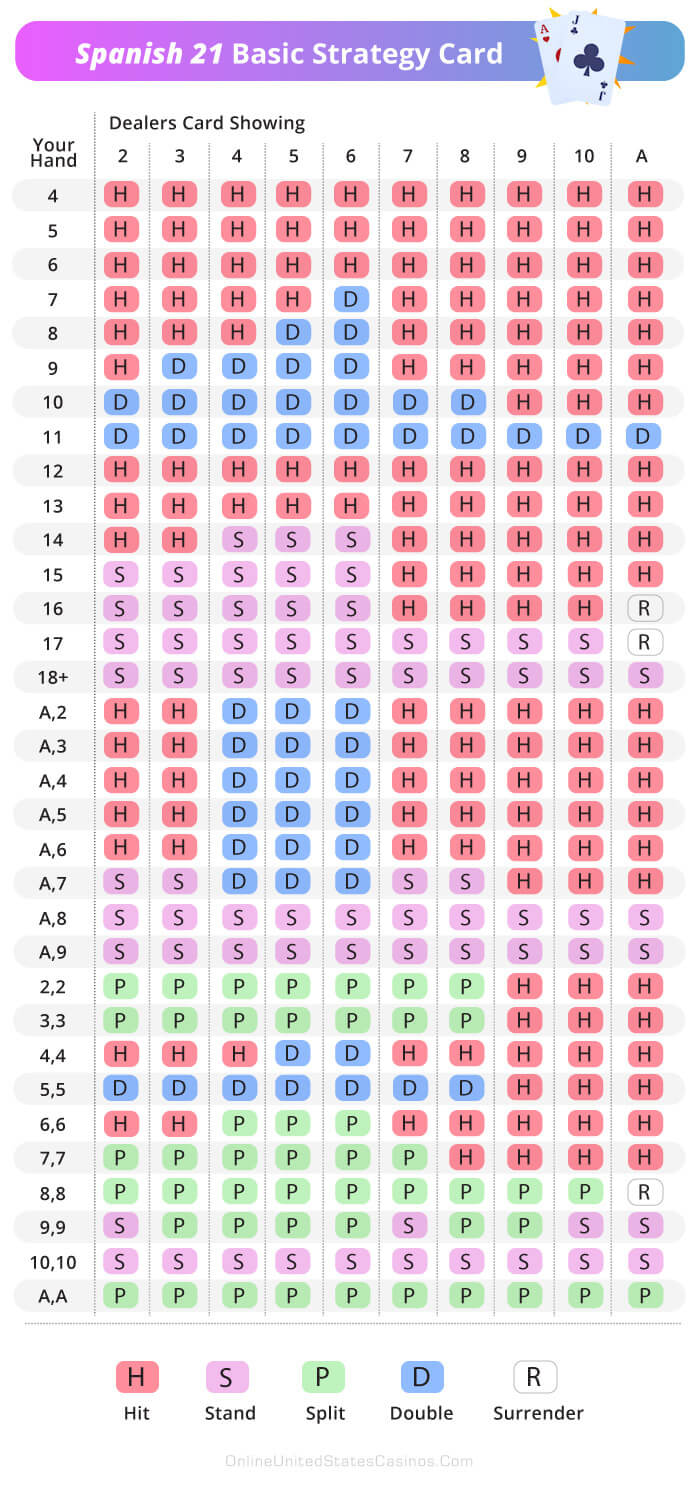Spanish 21
Spanish 21 Blackjack takes the classic game and adds some new rules. The 10s are removed from the deck. There are bigger payouts and a few bonus hands that stack the odds in your favor.
In this guide, I’ll explain the rules and gameplay and share strategy tips to improve your chances of beating that Spanish dealer.
Let’s get started!
Table of Contents
Choose Your Preferred Section
Spanish 21 Rules
The rules of Spanish 21 are similar to standard blackjack. Your goal is to beat the dealer by getting closer to 21 without going over. Anything above that is a bust that results in an automatic loss, so be careful!
While the rules are similar, key differences exist between the classic blackjack you know and love and the Spanish 21 variant.
Adding these rules and a dealer hitting on a soft 17 can drive the house edge down to a meager 0.4%.
No Tens
Spanish 21 uses 48-card decks, which is just your standard 52-card deck minus the four 10s.
There are still face cards, but you can hit more often and bust less frequently with fewer high cards. Getting a blackjack is also more difficult.
Card Values
- Aces can count as 1 or 11, depending on what works best.
- Jacks, Queens, and Kings are worth 10.
- Cards 2-9 are worth their face value.
Double Down
You can double down on any number of cards in hand. You can also double after splitting.
Surrender
While classic blackjack limits your surrender option to only the first two cards, Spanish 21 allows you to surrender at any point in the hand.
Re-Split Aces
If you split a pair of aces and get another ace, you can split the new pair again.
Player 21 or Blackjack Wins
If the player and the dealer have blackjack on their first two cards, the player wins the hand. The payout is a standard 3:2.
The player’s 21 also wins the hand even if the dealer has 21.
Bonus Hand Payouts
A five-card 21 pays 3:2, a six-card 21 pays 2:1, and a seven-card 21 pays 3:1.
Also, any 6-7-8 or 7-7-7 have special prizes depending on the suits. See the paytable below for more details.
Spanish 21 Payouts
The unique hands in this blackjack spinoff have extremely favorable payouts. Several conditions award you a 2 to 1 or even 3 to 1 prize. That’s one of the most significant factors that nudge this game’s house edge down even lower than standard blackjack.
Keep this table handy when making decisions on hitting and standing. It helps remind you of the hands that are unique to this variant.
| PLAYER | HOLDING | DESCRIPTION | PAYOUT |
|---|---|---|---|
| Dealer/Player | Blackjack | 2-Card 21 | 3:2 (Player Wins the Tie) |
| Player | Blackjack | 2-Card 21 | 3:2 (First Hand Only) |
| Player | 5 Card 21 | 21 on 5 Cards | 3:2 (Non-Doubled Hands) |
| Player | 6 Card 21 | 21 on 6 Cards | 2:1 (Non-Doubled Hands) |
| Player | 7 Card 21 | 21 on 7 Cards | 3:1 (Non-Doubled Hands) |
| Player | Mixed 6 7 8 | 6 7 8 Mixed Suits | 3:2 (Non-Doubled Hands) |
| Player | Suited 6 7 8 | 6 7 8 Same Suit | 2:1 (Non-Doubled Hands) |
| Player | Spades 6 7 8 | 6 7 8 All Spades | 3:1 (Non-Doubled Hands) |
| Player | Mixed 7 7 7 | 7 7 7 Mixed Suits | 3:2 (Non-Doubled Hands) |
| Player | Suited 7 7 7 | 7 7 7 Same Suit | 2:1 (Non-Doubled Hands) |
| Player | Spades 7 7 7 | 7 7 7 All Spades | 3:1 (Non-Doubled Hands) |
| Player/Dealer | 777 / Up 7 | Dealer Shows 7 & Player Has 777 | $1,000 – $5,000 Jackpot |
| Player | Other Winning Hands | No ties | 1:1 |
| Dealer/Player | Tie | Same Total | Push |
How to Play Spanish 21
This game is played just like traditional blackjack. Below, I’ll show how a hand progresses from the initial bet to the payouts.
You can also check out the differences between blackjack and Spanish 21.
Place Your Bets
You must make a wager to see your hand and the dealer’s up-card. Move your chips to the betting area to indicate you’re ready to play.Dealing the Cards
At the start of a hand, the dealer passes out the cards. Just like regular blackjack, you’ll get two face-up cards, and the dealer will get one face-up and one face-down. Remember, you won’t see any tens.Hit, Stand, Double, Split, or Surrender
Now that you have your cards, you must decide before setting your hand. You can hit for more cards, split pairs, pay more, and double down, or surrender to reclaim half of your initial bet.
There are fewer tens, so you can hit more often, but don’t take too many cards, or you might bust. When you’re happy with your hand, you can stand, indicating to the dealer that you are done.The Dealer Completes Their Hand
When all players complete their hands, the game passes to the dealer. They must abide by house rules when hitting and determining when to stand.Deciding Winners
Finally, they weigh all the player’s hands against their own to determine the winners. If your hand beats the house, then you’ll get rewarded based on the paytable.
Play Online for Free
Practice your tactics right here for free. Use the Spanish 21 strategy cheat sheet to get a swing of the rules before playing for real money.
They have the same cards and payouts, but this version has a match-side bet.
Strategy Tips to Reduce the House Edge
The strategy in Spanish 21 is slightly different from blackjack since the deck has fewer ten-valued cards.
Let’s look at some ways to increase your chances of winning, as well as the changes to standard gameplay that help you stay ahead of the dealer.
Stand & Hit
Always stand when you hold a hard 18 or greater. The same goes for any soft hand equal to or higher than 19.
You should always hit when you hold a hard 4, 5, 6, 12, or 13.
Doubling Down
You should always double down when you have a hard 11.
If the dealer shows a 4, 5, or 6, you should double with a hard 9-11, and when you have a soft 13 to 18.
Splitting Pairs
Always split a pair of aces and never split a pair of 4s or 5s.
When you hold a pair of 2s, 3s, 7s, or 8s, you should only split when the dealer shows between 2 and 7 up.
Note: Each Spanish 21 card game might have slightly different rules that affect the game’s odds. The house edge varies between 0.4% and 0.8% depending on how many the decks are in the shoe, when you can double, and whether the dealer has to hit on soft 17.
Basic Spanish 21 Strategy Chart
This cheat sheet shows you the best decision in all starting situations. It is slightly different from the standard blackjack strategy chart since fewer cards are in each deck.
Keep this Spanish 21 chart with you at the table so you can hit, stand, double, and split with the odds in your favor every time.

Time to Test Your New Skills!
I hope you learned the rules and strategies to play Spanish 21 with this guide. Now, it might be a good time to apply that new knowledge and try to win some money.
Go on, log in to a legit real money casino, keep your strategy chart handy, and have some fun with this blackjack spinoff.
It may take some time to get used to the unique rules, but the house edge is only 0.4%. I think it’s worth a try.
Frequently Asked Questions
Below are a couple of common questions players ask about Spanish 21.
Why is it called Spanish 21?
The Spanish 21-card game in casinos gets its name from the deck it uses. A “Spanish deck” is almost the same as a normal deck, except it only has 48 cards because the tens are removed.
Is Spanish 21 better than blackjack?
With favorable rules and perfect strategy, the house edge of Spanish 21 is a touch lower (0.4%) than standard blackjack tables (0.5%). That said, they do have slightly different decks and charts, so make sure you study each game closely before you play.
Can you count cards in Spanish 21?
Yes, you can count cards in Spanish 21. Like other blackjack tables, you would assign number values to certain cards to determine a running count. This can help you predict if the next card in the shoe is likely to be a high or lower value.
However, these strategies don’t work at online casinos. The single-player nature of software-based games doesn’t give you much to count, and the shoe usually gets shuffled after every hand.
Is Pirate 21 the same as Spanish 21?
Pirate 21, Pontoon, or Pirate Blackjack, is the same game as Spanish 21.
The name ‘Spanish 21’ belongs to developer Masque Publishing, so any site without that specific version uses different branding. The rules, house edge, and side bets are generally the same.
